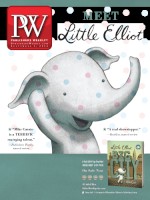In the North American publishing world, comics are comics and novels are novels. But if you peek into the manga section of your local bookstore, you might find a “light novel,” which, according to Leyla Aker, v-p publishing at Viz Media, “possesses elements of YA and genre fiction, combined with the uniquely Japanese element of the manga/anime connection.”
Light novels are Japanese prose works illustrated with manga-style drawings and are often adapted into manga and anime properties. While a few U.S. manga publishers dabbled in the books in the early 2000s, the category never quite took off. Now, Yen Press, Hachette Book Group’s graphic novel and manga line, has launched Yen On, a light novel imprint that will release at least 24 titles in 2015, and has plans to publish many more. Yen Press has already released several light novels, according to its publishing director Kurt Hassler, and, while its prose push is still young, he reported that results are promising.
“Our original plan with Yen On was to publish 24 titles in 2015, so two per month,” Hassler said. “However, our initial success and our confidence in this material has already prompted us to take a more aggressive approach. We will definitely be increasing our output well over 24 light novels next year.” Yen On is releasing its novels as trade paperbacks, with most priced at $13.
The term “light novels” was coined in Japan in the 1990s, but illustrated novels have been hot sellers with a devoted audience since the 1970s. The books are meant to be light entertainment: fast-paced serialized stories offered as inexpensive paperbacks. According to Japan’s Publishing Science Institute, light novels accounted for approximately 23.5% of the country’s general paperback sales in 2011. “Light novels are huge in Japan these days, and also in most countries in Asia,” observed Ju Youn Lee, senior editor at Yen Press. “In Korea, I think I would say that it’s even bigger than the manga market nowadays.”
For anime fans, gamers, and manga readers, light novels are the source material for many favorite series. Before they were anime, manga, or games, hit series like Sword Art Online, Haruhi Suzumiya, Spice, and Wolf and Durarara!! were bestselling light novels.
Among the light novels Yen On will publish in 2015 are Log Horizon by Mamare Touno (March 2015), illustrated by Kazuhiro Hara, in which 30,000 Japanese gamers are stuck in an online sword and sorcery realm fighting monsters; Pandora Hearts: Caucus Race by Shinobu Wakamiya (original story & illustration by Jun Mochizuki), short stories from the world of the bestselling manga/anime series; No Game No Life by Yuu Kamiya (April 2015), in which siblings Sora and Shiro, losers in the real life but unbeatable superstars in online gaming, are whisked away to a world where wars are decided by the outcome of games; and The Devil Is a Part-Timer! by Satoshi Wagahara (April 2015), illustrated by 029 (Oniku), in which the demon lord Satan is forced to retreat to a land—Tokyo!—where his powers are nullified and he’s forced to get a day job at a fast-food joint.
While Yen Press’s Yen On imprint is new, companies that have dipped their toes into the light novel waters to varying degrees of success include TokyoPop, Seven Seas Entertainment, Del Rey Manga, Viz Media, Dark Horse, and Digital Manga Publishing. Adam Arnold, managing editor at Seven Seas, said, “We began publishing light novels in 2006, but it wasn’t the time for it. Some of our titles, like Strawberry Panic, did really well for us. But we’ve just been cautious since then. It has to be the right book and the right market.”
Some manga publishers, like Viz Media and Seven Seas, have added a few carefully selected titles to their 2014–2015 lineups. Vampire Knight: Fleeting Dreams, a collection of short stories by Matsuri Hino and Ayuna Fujisaki, is due out in late 2014 from Viz Media’s Shojo Beat imprint. Meanwhile, Seven Seas is publishing Alice in the Country of Diamond: Bet on My Heart, a light novel set in Alice’s Wonderland and created by visual novel developer QuinRose.
Hassler is not discouraged by light novels’ checkered U.S. sales history to date, citing results of Sword Art Online: Aincrad which has sold over 30,000 copies since its release in April. Publishing light novels comes with its own set of challenges. The books have more words per page than traditional prose novels, which means higher translation costs, and getting booksellers and librarians on board will be difficult for a format that overlaps with, but doesn’t quite fit within, the manga or YA novel categories.
“Anything new can be met with a certain degree of skepticism,” said Hassler. “Ten to 14 years ago, though, manga was no different. Because of the preexisting awareness built in with the manga fans and the fact that there are often companion manga series to so many of these light novel titles, we’re advising stores to shelve the books with their manga for now, and that seems to be working quite well. I don’t think it’s a stretch to imagine that in the not too distant future light novels could command their own sections in stores.”



 Volume 261
Issue 35
09/01/2014
Volume 261
Issue 35
09/01/2014





